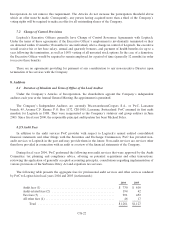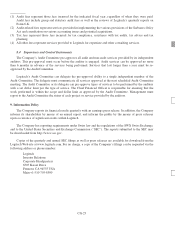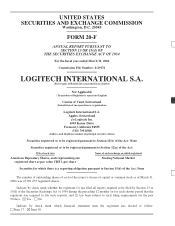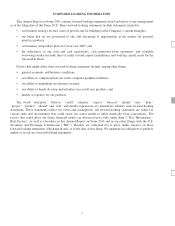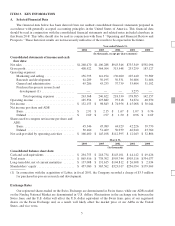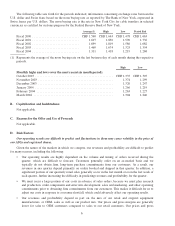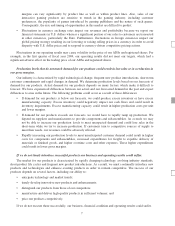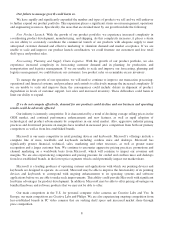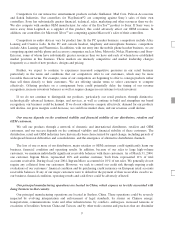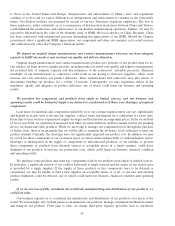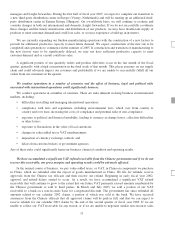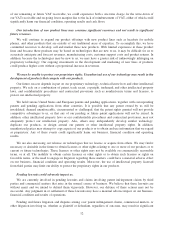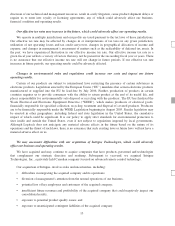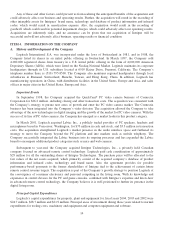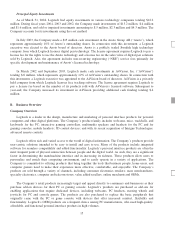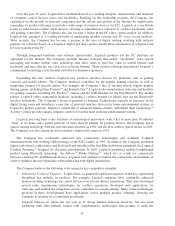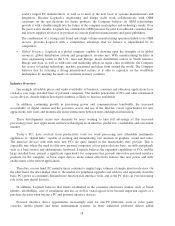Logitech 2004 Annual Report Download - page 46
Download and view the complete annual report
Please find page 46 of the 2004 Logitech annual report below. You can navigate through the pages in the report by either clicking on the pages listed below, or by using the keyword search tool below to find specific information within the annual report.Our failure to manage growth could harm us.
We have rapidly and significantly expanded the number and types of products we sell and we will endeavor
to further expand our product portfolio. This expansion places a significant strain on our management, operations
and engineering resources. Specifically, the areas that are strained most by our growth include the following:
New Product Launch. With the growth of our product portfolio, we experience increased complexity in
coordinating product development, manufacturing, and shipping. As this complexity increases, it places a strain
on our ability to accurately coordinate the commercial launch of our products with adequate supply to meet
anticipated customer demand and effective marketing to stimulate demand and market acceptance. If we are
unable to scale and improve our product launch coordination, we could frustrate our customers and lose retail
shelf space and product sales.
Forecasting, Planning and Supply Chain Logistics. With the growth of our product portfolio, we also
experience increased complexity in forecasting customer demand and in planning for production, and
transportation and logistics management. If we are unable to scale and improve our forecasting, planning and
logistics management, we could frustrate our customers, lose product sales or accumulate excess inventory.
To manage the growth of our operations, we will need to continue to improve our transaction processing;
operational and financial systems; and procedures and controls to effectively manage the increased complexity. If
we are unable to scale and improve them, the consequences could include: delays in shipment of product,
degradation in levels of customer support, lost sales and increased inventory. These difficulties could harm or
limit our ability to expand.
If we do not compete effectively, demand for our products could decline and our business and operating
results could be adversely affected.
Our industry is intensely competitive. It is characterized by a trend of declining average selling prices in the
OEM market, and continual performance enhancements and new features, as well as rapid adoption of
technological and product advancements by competitors in our retail market. Also, aggressive industry pricing
practices and downward pressure on margins have resulted in increased price competition from both our primary
competitors as well as from less established brands.
Microsoft is our main competitor in retail pointing devices and keyboards. Microsoft’s offerings include a
complete line of mice, trackballs and keyboards including cordless mice and desktops. Microsoft has
significantly greater financial, technical, sales, marketing and other resources, as well as greater name
recognition and a larger customer base. We continue to encounter aggressive pricing practices, promotions and
channel marketing on a worldwide basis from Microsoft, which will continue to impact our revenues and
margins. We are also experiencing competition and pricing pressure for corded and cordless mice and desktops
from less-established brands, in the lower price segments which could potentially impact our market share.
Microsoft is a leading producer of operating systems and applications with which our pointing devices and
keyboards are designed to operate. As a result, Microsoft may be able to improve the functionality of its pointing
devices and keyboards to correspond with ongoing enhancements to its operating systems and software
applications before we are able to make such improvements. This ability could provide Microsoft with significant
lead-time advantages for product development. In addition, Microsoft may be able to offer pricing advantages on
bundled hardware and software products that we may not be able to offer.
Our main competitors in the U.S. for personal computer video cameras are Creative Labs and Veo. In
Europe, our main competitors are Creative Labs and Philips. We are also experiencing ongoing competition from
less-established brands in PC video cameras that are seeking shelf space and increased market share through
price competition.
8


